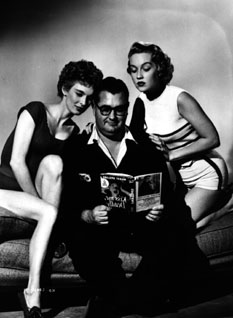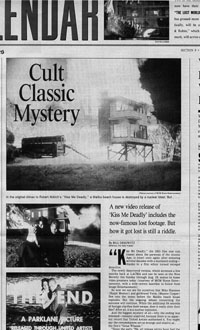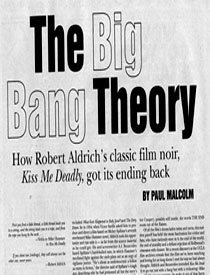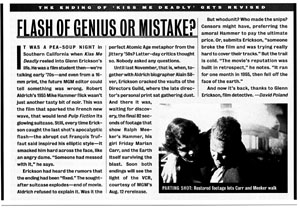| Release List | Reviews | Price Search | Shop | Newsletter | Forum | DVD Giveaways | Blu-Ray/ HD DVD | Advertise |
| Reviews & Columns |
|
Reviews DVD TV on DVD Blu-ray International DVDs Theatrical Reviews by Studio Video Games Features Collector Series DVDs Easter Egg Database Interviews DVD Talk TV DVD Talk Radio Feature Articles Columns Anime Talk DVD Savant HD Talk Horror DVDs Silent DVD
|
DVD Talk Forum |
|
|
| Resources |
|
DVD Price Search Customer Service #'s RCE Info Links |
|
Columns
|
 |
KISS ME DEADLY: |
|||||||||||||||||||||||||
 |
You can link to the Kiss Me Deadly restoration in two separate articles in the Web
Journal that 'broke the story', Gary Johnson's IMAGES:
Alain Silver's original 1996 speculation about the then 'still missing' ending: So What's With the Ending of KISS ME DEADLY? Glenn Erickson's followup 1997 restoration article: |
In the second article, a theory was put forward that a film
handling error damaged the last scene, and the sloppy recut was done to cover the error.
After further research, I now believe that purposeful censorship, and not a simple mishap,
was responsible for the mangling of Deadly's conclusion. This possibility is best
discussed in Paul Malcomb's LA Weekly article of August 15, 1997. But two documents
uncovered later bring even more light to the issue:
While going through boxes of original still negatives I came across two items. The first was
an (unpublished?) 1955 Robert Aldrich letter to Daily Variety. Aldrich, ever the champion
of the rights of independent Hollywood production, called upon producers to band together
against the censorship of independent films by local censor boards. This was long before the
MPAA rating system; in 1955 every state, many cities, and even separate church parishes
held censor rights to their territories. Hollywood had to find ways to economically
distribute movies in a climate where the slightest 'offensive' content could result in a film
not being shown. Studios were known to prepare multiple versions of movies, the most notorious
being MGM, who routinely engineered their musicals to enable the deletion of scenes with
black performers, e.g., The Pirate. What Aldrich deplored in his article was the plight
of of the independent producer who finds himself fighting both the censors and his own
industry: if a particular producer's movie met with resistance from the tyrannical censor
boards, instead of standing behind him, other studios would rush to fill the gap with their
own product. A situation had been cultivated, argued Aldrich, that stifled creativity and
punished innovation, while giving the local boards unreasonable power. This is why in the
'50s the mainstream cinema still had married couples sleeping in twin beds, simple realities
like toilets were never seen in bathrooms, and words like 'virgin' could not be spoken
in any context. Read biographies of Nicholas Ray or John Huston and you will see time
and again how attempts to present any but the most sanitized versions of books or plays
were stymied by Hollywood's desire to placate these regional censor boards.
Aldrich mentions a particular parish censor, Lloyd Binford of Memphis, Tennessee. Because
a huge part of the South followed his dictates, he wielded enormous power over Hollywood
production, and apparently he refused to let Kiss Me Deadly be shown. This leads
Savant to believe that a United Artists attempt to 'sanitize' Deadly, not a film
handling error, is a far more likely reason for the re-edited ending.
Aug. 12, 1997

The second document is a letter from the head of the UA sales department to his staff, the bookers responsible for getting United Artists films shown on as many screens as possible during their theatrical runs. The letter chastized the sales force for failing to obtain sufficient bookings for Deadly to insure the film a chance at profitability. The previous Victor Saville Spillane adaptations, I, The Jury and The Long Wait, had fared quite well, even with less than rave reviews. From this executive's letter, it is clear that Deadly was not doing well at all. Were local territories refusing to book the film? Was Lloyd Binford keeping Deadly out of a huge chunk of the South?
As producer, Aldrich was probably demanding to know why his film was not in theaters. The letter may have been written to convince Aldrich that every effort was being made to sell a title that exhibitors just didn't want. No mention is made of the film's being branded as degenerate filth unfit for American exhibition by church groups, the Catholic Legion of Decency, and the U.S. Congress.(see the Mangled article) What made Aldrich's letter so gutsy was that, like blacklisting, the tyranny of local censors was rarely discussed in public. For UA Aldrich was just another minor independent producer. His total personal fee for producing and directing Kiss Me Deadly was only 25,000 dollars - the only way he had of making money on the film was if it became a runaway hit.
So, another speculative scenario: The Bible Belt, under the leadership of Lloyd Binford of Memphis, rejects Kiss Me Deadly, placing the UA sales department in a tight spot. Management demands the film be gotten into more theaters or else, and with a minumum of expense. A UA sales exec contacts Binford, and while negotiating gets the parish overlord to state Deadly's major offense. Here is where Savant has to propose that Binford's objections centered around the fact that the pimping, murdering, promiscuous 'hero' Mike Hammer is not punished for his sins at the finale. The executive gets an inspiration and asks if the situation would be alleviated if Hammer did not escape from the burning house, if it were made to appear that he and Velma paid for their sins in a fiery holocaust. Well, alright then, says Binford.
The exec pulls in an editor, and they take a look at the end of the film. The editor says all the shots of the couple escaping onto the beach can be eliminated. Some reshooting would help, a better house-burning shot, perhaps, and a new optical end title. That, and a remix of the soundtrack might cost ten thousand dollars. Making a dupe negative of the last reel for this alternate version would be pricey as well. This is unacceptable to the exec., not only for the expense but because he wants to effect this change quietly - the outspoken Robert Aldrich would never consent to it. Altering the film behind the director's back would be against UA's contract with Aldrich, an act impossible to hide from him later if there were lab bills on file and alternate versions in the vaults. Does the editor have a cheaper alternative? Well, yes. Just chop out the offending shots, splice the angles of the burning house together and super a generic THE END title over it, a $75 quickie optical. There would be no alternate version, the film's ending would be changed forever.
The final decision is to covertly cut the original negative, obliterating Aldrich's ending. The film will end with an abrupt cut to black and the soundtrack will just raggedly cut off. Censor Lloyd Binford will get his customized version, the film will disappear after a few weeks, and the problem will be forgotten.|
Aug. 15-21, 1997  |
The above is yet another supposition, but Savant believes it makes far more sense than his earlier torn-film theory. Now that the missing scene is known to last more than a minute, it is less likely that any simple negative tear would prompt the tossing of so much footage, especially when the burning house shots remain undamaged. The unpublished Aldrich article and the executive letter support it at least 50% of the way. |
In interviews taken decades later, it is clear Aldrich never knew his film had been altered at such an early point, even when the possibility was suggested to him. In any event, he sold all rights to Kiss Me Deadly back to United Artists only a couple of years later.
Perhaps the sale to the South was rejected anyway, even after the ending was changed. In any case, there was no sudden upswing in Kiss Me Deadly's boxoffice. Initially offered in television syndication packages in 1959, it soon fell from common TV distribution: UA records show it being dropped from one package after another without explanation (unsuitable for family viewing?). Aldrich seemingly never screened his personal print, the one found in the possession of the Director's Guild. He was the kind of Hollywood creator who never looked back. In less than two years he would find himself leaving Hollywood altogether. Columbia's Harry Cohn fired him from The Garment Jungle when he realized that the caustic monster-mogul portrayed in Aldrich's The Big Knife was meant to be Cohn himself.
The gratifying thing about the restoration of Kiss Me Deadly is knowing that it was not a simple case of stumbling across a 'lost ending.' Finding a missing piece of film in a vault can be a dumb accident; in this case locating the film itself was simple. The accomplishment was perceiving that there was a lost ending to be found in the first place, and Savant is very proud to have had a share in this.
Note: Apparently complete, original prints of Kiss Me Deadly existed before the restoration, if a couple of letters published in Video Watchdog and elsewhere are to be believed. A German reader claimed their TV print was intact. An LA patron said the Nuart Theater in West LA showed the uncut ending. Since the Nuart is only a mile from MGM/UA and officially booked UA's cut print, perhaps someone there was substituting a privately owned last reel. Having never heard about these 'complete' prints before (and neither had Alain Silver, nor Martin Scorsese or Bertrand Tavernier, who collectively would be expected to know everything there is to know about Deadly), Savant didn't know how to react. With this in mind the wording of all announcements read that the film ' has been predominately shown only in its cut version, for 40 years.' If the ending was already known to the public, how come there has been no mention of it in print or complaints from fans and experts, for so long? How come reviewers and film critics have been debating only the mangled ending version at such great length, often going so far as to comment on its disjointed bluntness as a daring inspiration for the French New Wave? Savant is certain that before the restoration, the uncut Kiss Me Deadly was a rarity.

|
|
| Coming Soon |
|
|
| Special Offers |
|
|
| Columns |
| Home | Release List | Coupons | Shop | Reviews | Forum | Video Games | Price Search | Advertise |









